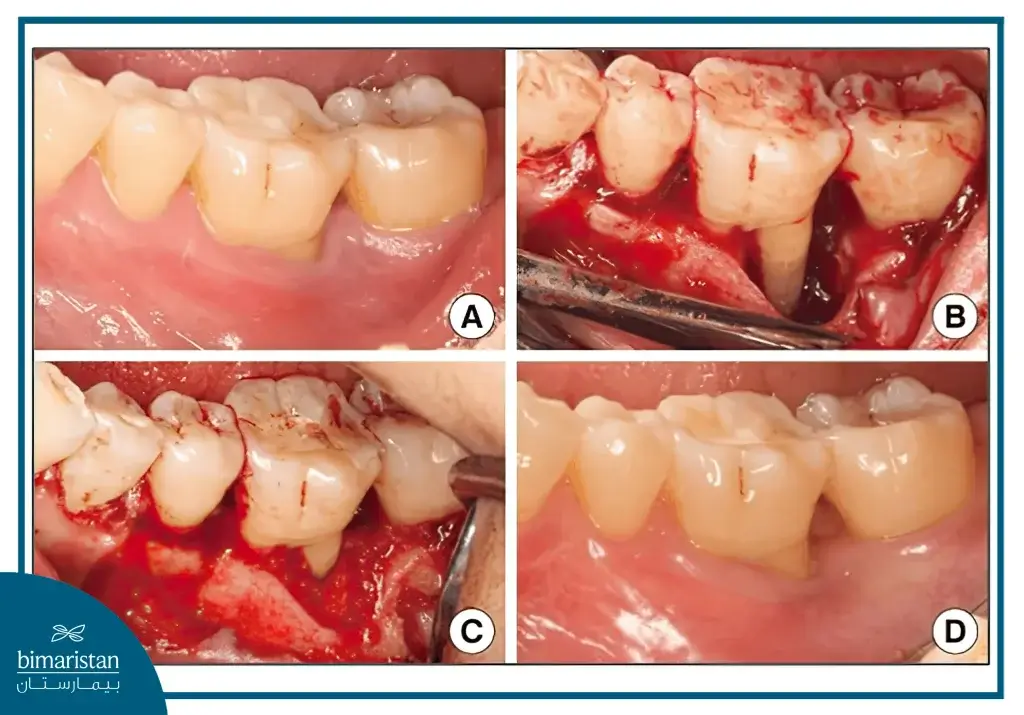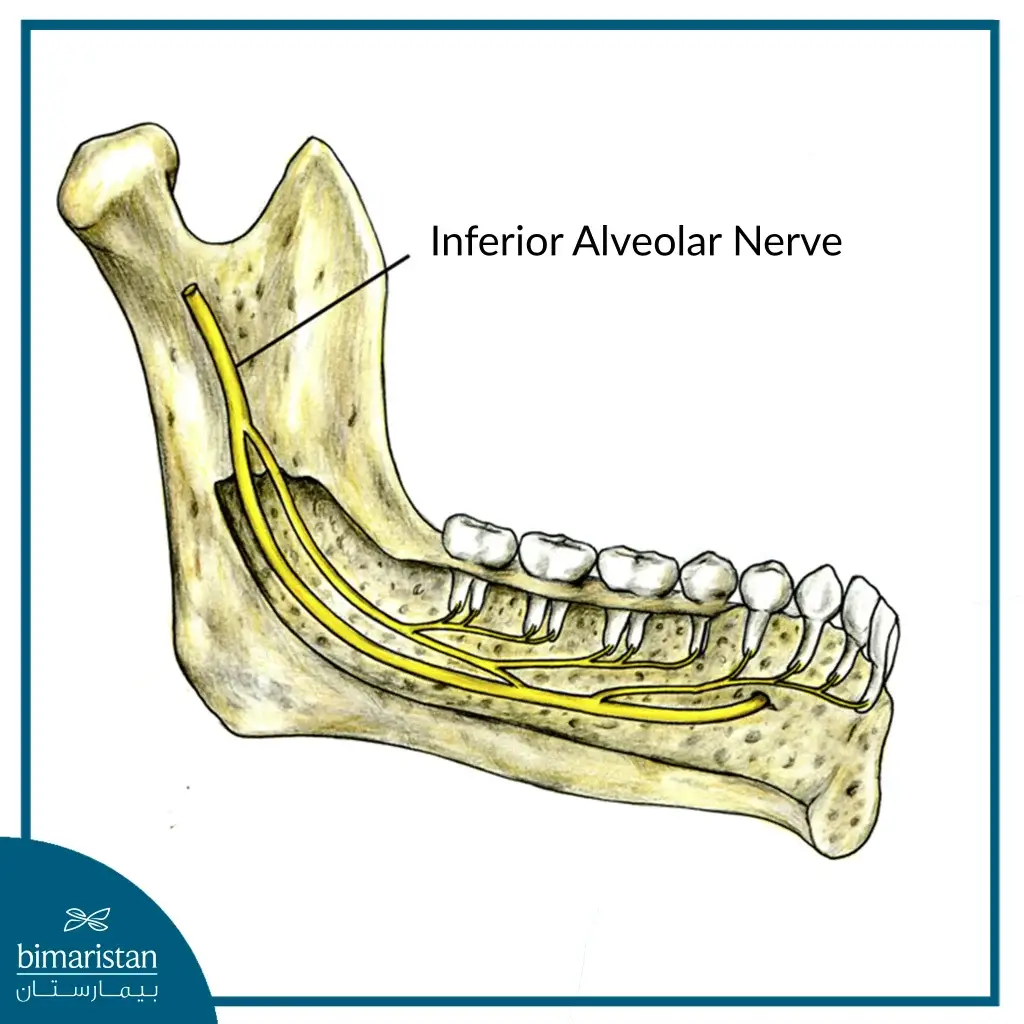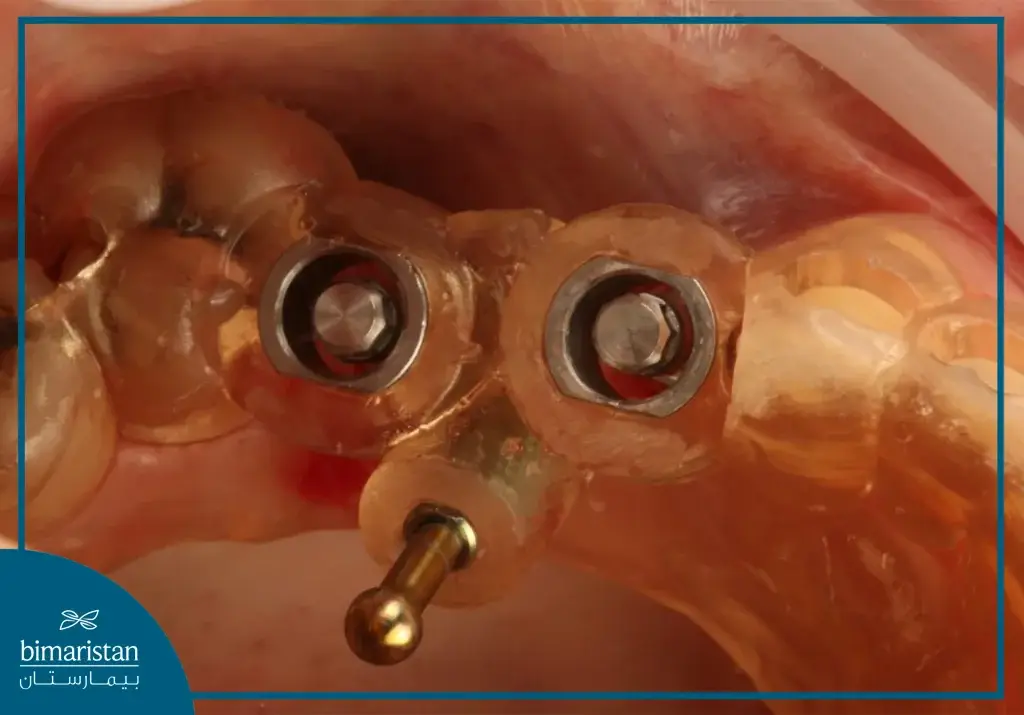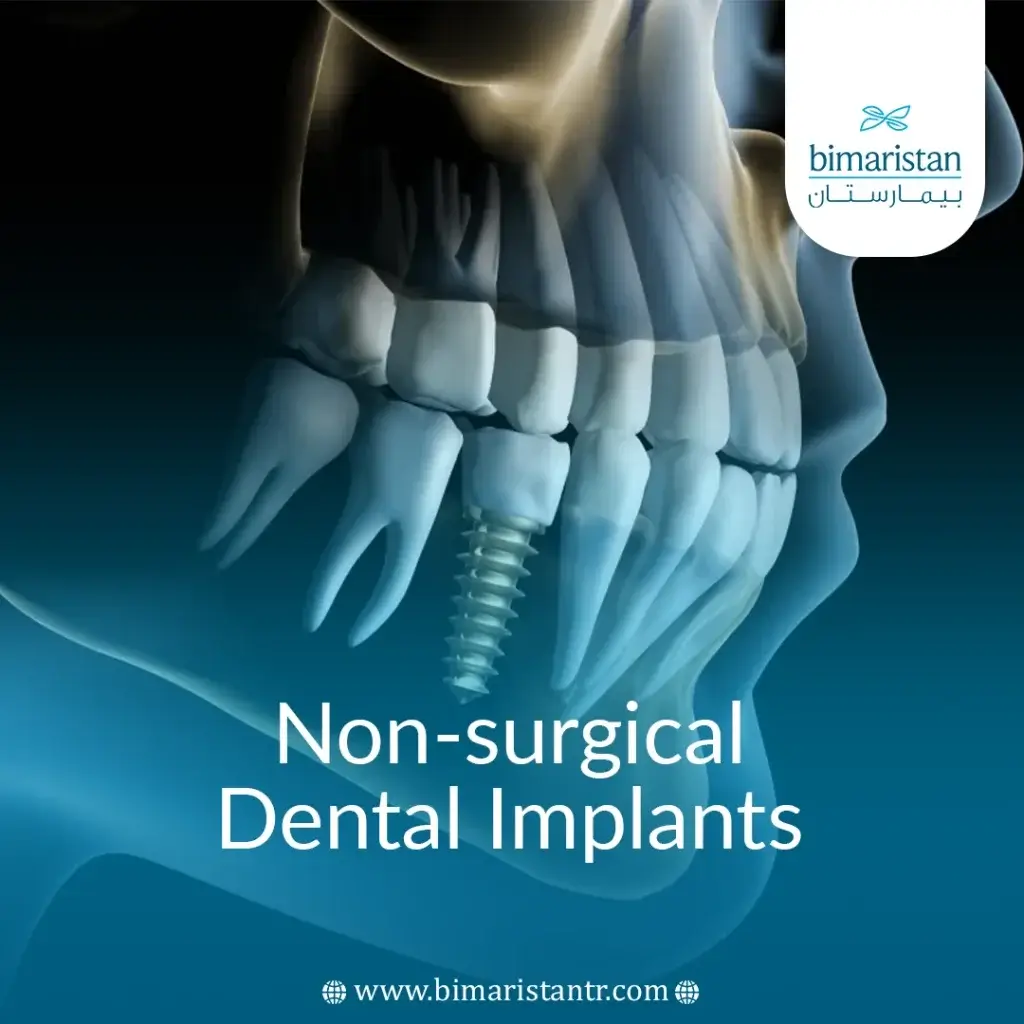This article explores the latest 2024 non-surgical dental implants in Turkey/Istanbul, using 3D-printed surgical guides for precise and advanced implant methods.
In recent years, advancements in non-surgical dental implants, imaging technologies, and the digital revolution have led to the rise of Computer-Assisted Implantology (CAI), or guided implantology.
This innovative technique prepares dental implants using a digitally manufactured guide without compromising the basic rules of modern dental implantology, where the prosthetic project controls the position of the implant and, thus, the surgery.
The main goal of this surgical technique is to help dental implantologists preserve the anatomical structures of the upper jaw and enable them to perform a quick, less invasive cosmetic procedure.
This article will briefly discuss the history of guided implantology, its principle, the different stages of the protocol, the guide manufacturing technique, its advantages and limitations, and an overview of the different concepts and systems currently available and the different types of guides possible.
A historical overview of dental implantology using a surgical guide

The first guides date back to 1999 and were then bone-supported. The usual (deep invasive) flap surgery was necessary to place the guide in the correct position on the bone. After the flap was lifted, the inner surface of the guide was fixed directly on the bone.
These guides were made using 3D bone reconstruction techniques by converting DICOM radiographic files into STL files. Therefore, due to the problems encountered with the radiographic guides used during that period, the first beneficiary of guided surgery was the completely edentulous patient.
The idea was to simplify complex and deep invasive surgeries.
A few years later, in 2002, the mucosal-supported surgical guide was developed, thanks to the use of the radiopaque palate that determines the volume of soft tissue.
The dual-scan technique was used to produce mucosal-supported guides for flap-free surgery. As its name indicates, this technique can avoid flap lift and use a trans gingival procedure.
We can differentiate between bone and soft tissue areas thanks to X-ray CT (scanner and cone beam).
The inner surface of the imaging guide can be used to model the surgical guide accurately.
The latest generation guides are now made using digital laboratory models, and the latest advances have included using intra-buccal optical impressions to design the surgical guide.
Guided dental implants are now used to treat patients with partial edentulousness.
All-on-four implants can also be used as an alternative to guided implants.
The working principle of non-surgical dental implants
Guided implant surgery uses a computer planning program that allows the patient’s radiological (DICOM file) and clinical (.STL file) data to be combined and matched.
DICOM files are created using a cone beam X-ray or scanner.
While STL files are created by digital impressions of the patient’s mouth (with the development of imaging methods, this file is no longer needed), all these digital files are then superimposed and matched either automatically or manually.
The goal of the matching is to synchronize the radiographic data with the tooth and gum surfaces on which the surgical guide will be placed.
Stages of planning non-surgical dental implants
A dental restoration project can be wholly digitalized with this technology.
The dentist first takes x-rays of the jaw, a cone beam computed tomography (CT) scan, and a scanner and combines all this information to create a virtual model on the computer.
Making a surgical guide requires a combination of three elements:
- DICOM data from the cone beams.
- Scanner information.
- Digital impressions of the patient.

The planning software can be used to highlight the inferior alveolar nerve.
Once this information is integrated, it is time to determine the implants’ position, length, and axis. The software can be used to determine the need for bone grafting or sinus lift and to predict the installation method, as the angles and position of the implants can be calculated precisely on the computer.
In the case of multiple implants, it is also possible to control their alignment and alignment.
A virtual surgical guide is then created that directs the implant as planned.
Once the surgical guide is ready, it is modeled in an STL file, which is then exported for printing.
Production via 3D printing
Many methods for manufacturing the required models, such as FDM and SLS. However, 3D printing has seen a real boom over the past few years thanks to SLA (Stereo Lithography) technology.
This technology polymerizes light-sensitive liquid resin layer by layer using a laser beam. It combines a high degree of precision (print thickness up to 10 micrometers) with perfectly smooth surfaces.
Manufacturers increasingly sell ergonomically designed printers that are affordable and easy to use, suitable for dental procedures. This creates a new market for dental surgery.
Once the guide has been printed, it must be cleaned by immersion in an isopropyl alcohol bath for 20 minutes, then washed, dried, and polymerized in a UV oven.
The device can then be sterilized by autoclaving or gamma rays, or by cold sterilization, by immersion in a chlorhexidine solution.
The different types of surgical guides

- Depending on the surgical technique, several surgical guides are available: modification guides that use only the drill or fully guided surgical guides.
- The diameter of the cylinders into which the titanium tubes will be inserted may vary depending on the type of guide required.
- Implant guides also vary depending on the type of support: tooth, mucosa, or bone.
- Bone-supported surgical guide This type of surgical guide requires significant elevation of the mucosa flap.
- Mucosa-supported guide This guide is recommended for cases of complete tooth loss. Its main advantage is the minimally invasive Flapless surgical technique that eliminates the need to use a periosteal flap. However, it requires a certain degree of expertise to handle. This guide must be used with a dental occlusion aligner, and then a fixation screw (also known as a transosseous pin) must be placed to hold it in place with maximum stability. The bearing surface on which the guide will rest is the mucosa, a compressible surface that is 3 to 4 mm thick. Uneven pressure can cause it to tip and create a deviation in the initial impact point and, thus, in the planned implant angle.
- A tooth-supported guide is suitable for partial anterior or posterior tooth loss and cases of open toothless areas on one side of less than 30 mm. It can also be used in surgical procedures with or without flaps. This guide is the most accurate surgical guide, especially in cases of toothless areas.
Advantages of Guided Surgery
Guided surgery has made it possible to improve traditional dental implant techniques that require precision in the choice of the implant axis, its proximity to the roots of adjacent teeth, and various anatomical elements.
Guided surgery can be used to anticipate anatomical obstacles, estimate the volume of remaining bone, and consider its suitability for the axis of the implants to be implanted. This is in contrast to traditional dental implants, where the bone formation of the implant site primarily guides the drilling.
In addition, the intervention time is much shorter, the surgery is repeatable and less invasive, and the traceability is much simpler.
With this technique, non-surgical dental implants and same-day implants can be placed without the need for traditional surgery.
This benefits both the patient and the physician, as flapless surgery reduces the surgeon’s stress and the need for improvisation during the intervention. In addition, it makes surgical procedures safe by respecting the bone condition.
The precise placement of the implant in the available bone can help reduce the need for grafts and even allow the use of implants in complex cases where anatomical constraints previously prevented treatment.
In addition, this technique improves prosthetic outcomes and simplifies the prefabrication process of prostheses.
Guided surgery ensures better postoperative management. It can reduce the risk of preoperative bleeding, infection, pain, and inflammation after surgery for an optimal recovery rate.
The surgical guide can also be considered a communication tool with the patient. It can explain procedures and instill confidence by visualizing different aspects of the pathological condition. This tool can also offer real educational potential.
Difficulties and Limitations Associated with Guided Dental Implant Technique in Turkey
Though this technique offers safety for clinicians, non-surgical dental implants still require careful adherence to anatomical fundamentals throughout all process stages.
The first problem with computer-assisted surgery is the minimal opening of the mouth and the frequent impossibility of placing implants in the posterior section of the jaw, especially when the guide is present, as it is difficult to insert the drill into the sleeves. The authors also noted that the technical sophistication inherent in guided surgery requires a relatively steep learning curve, as it is a very sensitive and operator-dependent technique and should be adopted cautiously.
Some benign complications have been reported. There were also some differences between simulation and reality.
Level of Accuracy in Guided Dental Implants
The search for accuracy is paramount at all stages, and it requires careful application of protocols at all stages, such as digital planning, planning and implementation of the surgical guide, implementation of the implant using guide cylinders (sleeves), and finally, placement of the prosthetics.
The difference between the actual postoperative position of the implant and its theoretical position in the implant planning software is determined by measuring three parameters:
- Deviation at the point of impact of the drill (in millimeters) or the level of the implant collar
- Deviation at the apex (in millimeters)
- Implant angle (in degrees): deviation in the mesiodistal or vestibular-palatal/lingual direction
Many studies have addressed the question of the surgical guide’s accuracy. Companies developing systems and surgical guide software are marketing this improvement in accuracy. Is it a myth, or is it real? What is the truth?
Non-surgical dental implants via guided surgery involve X-rays, computer simulations, and the creation of a stereolithography guide. While SLA technology boasts a low error rate (0.1%), studies show stereolithographic guides aren’t completely error-proof, potentially affecting surgical accuracy.
Sarment et al. concluded that implant placement with a guide can reduce discrepancies compared to conventional surgery.
In another study, Nicking et al. recognized that the guide is somewhat helpful but may result in clinically unacceptable values.
Studies conducted by Ozan and Schneider found that there is a slight difference in planning depending on the type of guide support.
The tooth-supported guide is unanimously considered the most accurate, followed by the mucosal-supported guide and, finally, the bone-supported guide.
It seems that regardless of the type of support, the variability in the position of the implant apex is always greater than the variability in the collar. The literature indicates that the average deviation from the implant collar is about 1 mm and that the apex is about 1.5 mm, with highly variable standard deviations for both values.
For angular deviations, the level of accuracy of the tooth-supported guide is much higher than that of other evidence.
The financial cost of non-surgical dental implants
Despite the numerous benefits, non-surgical dental implants using guided surgery are not yet widespread, primarily due to high costs, which significantly affect implant treatment prices. However, 3D printing in dental surgery can help reduce costs. More dental implantologists and surgeons are adopting this approach, which requires training to master the lithography technique. It is a straightforward process that minimally impacts implant treatment costs.
Conclusion about non-surgical dental implants using surgical guides
The complete digital flow allows the virtual digital project to be transferred directly to the planning software to create a surgical guide in the form of a . STL file, producing a custom medical instrument.
For financial reasons, the traditionally customized guided surgery protocol for complex cases has become increasingly part of implant surgery treatment plans.
The significant discrepancy in research results regarding non-surgical dental implants and the precision promised by this technology suggests that blind faith in surgical guides is unwise. While guided surgery offers valuable support, the knowledge and experience of the dental surgeon should not be underestimated.
Sources:
